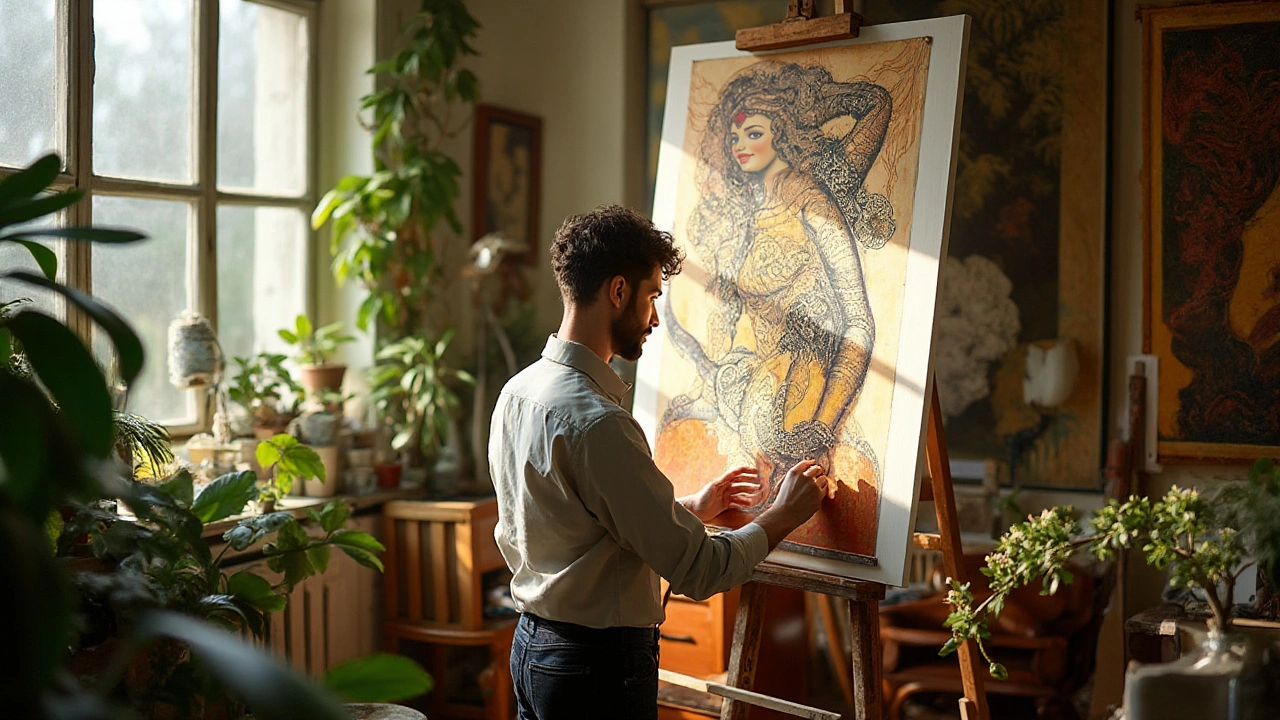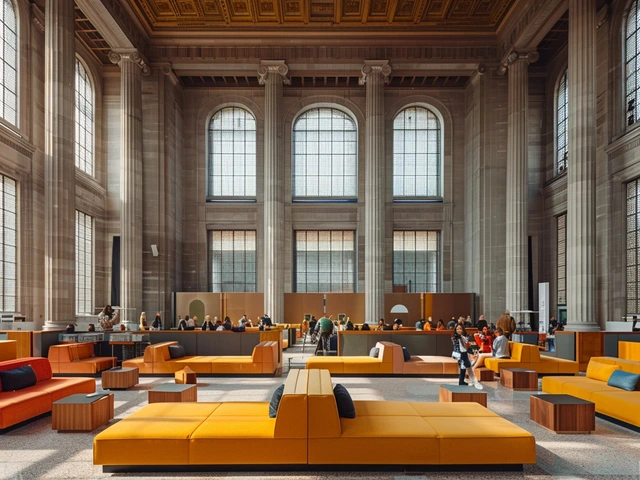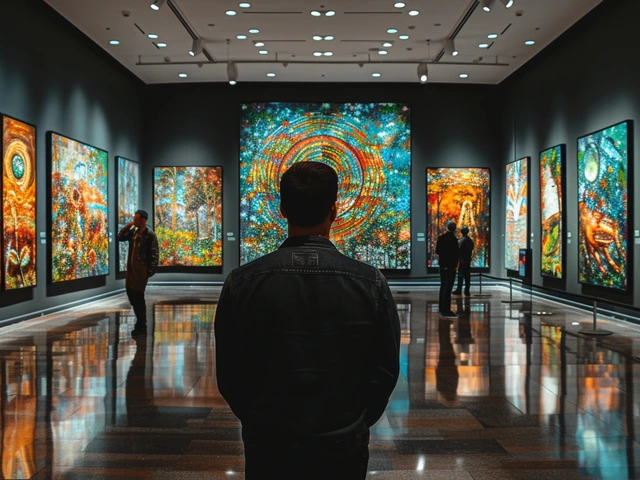Art Nouveau, with its flowing lines and organic forms, emerged at the tail end of the 19th century, transforming how art, architecture, and design were perceived. It wasn’t just a style but a movement that aimed to break away from historical art conventions, infusing every corner of daily life with beauty and creativity.
The movement began as artists and designers grew weary of traditional forms. They sought to create something new, fresh, and distinctly modern. This led to an explosion of creativity that transcended painting and sculpture, influencing architecture, furniture, jewelry, and even everyday objects.
Several key figures pioneered the Art Nouveau style, leaving behind a legacy that continues to be studied and admired. These visionaries crafted buildings that seem to defy gravity, designed furniture that was as functional as it was beautiful, and created artworks that captured the imagination with their intricate detail.
Today, a century later, the impact of Art Nouveau can still be seen. From cityscapes adorned with its iconic architectural designs to everyday household items that echo its aesthetic, the movement's influence remains strong. This article will explore the origins, key contributors, enduring influence, and lesser-known facts about this timeless art style.
- Origins and Evolution
- Key Figures
- Architectural Impact
- Art Nouveau in Everyday Objects
- Modern Influence
- Interesting Facts and Tips
Origins and Evolution
Art Nouveau, meaning
Key Figures
Art Nouveau flourished at the hands of some remarkable artists and designers. These visionaries didn't just follow trends – they created them. One of the most notable names associated with Art Nouveau is Alphonse Mucha. Mucha's posters and advertising designs, steeped in vibrant color schemes and intricate patterns, captivated the public’s imagination. His work on the famous 'Gismonda' poster for actress Sarah Bernhardt launched him into stardom, making his name synonymous with the movement.
Another towering figure is Antoni Gaudí, whose architectural masterpieces transformed the landscape of Barcelona. Gaudí's buildings, like the iconic Sagrada Família, are adorned with sinuous lines and organic shapes, capturing the very essence of Art Nouveau. It's fascinating how he managed to integrate nature’s forms into structures, blending functionality with sheer beauty. Gaudí’s work continues to draw millions of visitors each year, a testament to his lasting impact.
Then there’s Hector Guimard, who brought Art Nouveau to the streets of Paris with his unforgettable Metropolitan entrance signs. These wrought-iron structures, with their flowing and natural designs, embody the spirit of the era. Guimard's work demonstrated the versatility of the style and how it could elevate ordinary objects into works of art. His designs speak to how Art Nouveau wasn't just confined to galleries but infiltrated daily urban life.
In the realm of decorative arts, we must give credit to Louis Comfort Tiffany. His stained-glass designs are still celebrated for their brilliant use of color and intricate patterns. Tiffany’s studios produced everything from lamps to windows, each piece infused with his distinctive touch. The term 'Tiffany lamp' is now part of the artistic lexicon, highlighting his substantial influence on decorative arts.
Another notable mention is Gustav Klimt, whose paintings epitomize the lush, ornamental qualities of Art Nouveau. Klimt’s 'The Kiss' remains one of the most recognizable and cherished paintings worldwide. His works often featured elaborate patterns and gold leaf, creating a luxuriant, almost otherworldly feel. Klimt’s focus on the human figure and intricate detail set him apart as a master of the movement.
Finally, no discussion of key figures would be complete without René Lalique. Lalique excelled in jewelry and glass making, pushing the boundaries of what was possible in these mediums. His pieces combined natural motifs with exquisite craftsmanship, making them highly sought after during his time and in contemporary collectors’ markets. Lalique's contributions helped to make fine art accessible and wearable, broadening the appeal of Art Nouveau.
In sum, these artists and designers each brought something unique to the movement, weaving a rich tapestry that has stood the test of time. Their influence can still be felt in modern designs, and their legacy continues to inspire new generations. As we reflect on their contributions, it's clear how Art Nouveau was more than just a passing trend – it was a revolutionary movement that reshaped the world of art and design.
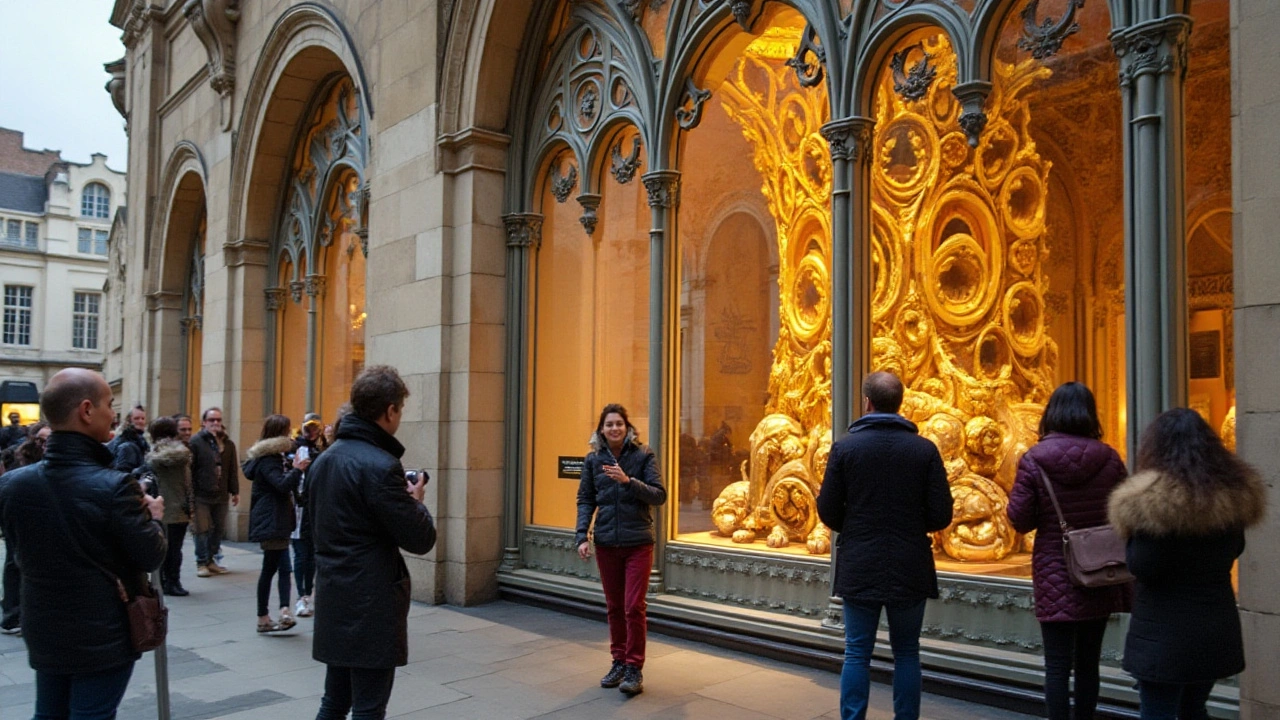
Architectural Impact
The architectural impact of Art Nouveau is impossible to overlook. This movement brought a breath of fresh air into late 19th and early 20th-century architecture, characterized by its use of intricate designs, organic forms, and flowing lines. Rather than relying on classical forms and straight lines, Art Nouveau introduced an emphasis on natural forms and curves, helping to blend buildings more harmoniously into their surroundings.
One of the most renowned examples is the work of Antoni Gaudí. His masterpiece, La Sagrada Familia in Barcelona, continues to amaze visitors with its detailed façades and whimsical spires. Gaudí’s use of innovative techniques and materials helped pave the way for modern architecture, making him a central figure in the Art Nouveau movement.
Not far behind Gaudí, we find Victor Horta's Hotel Tassel in Brussels, an early and influential example of Art Nouveau architecture. This building showcases Horta’s signature style, characterized by its organic ironwork, stained glass, and extensive use of natural light. The open floor plan and the seamless blend of decorative elements with structural features make it a landmark of Art Nouveau design.
Another architectural gem is the Paris Métro, designed by Hector Guimard. His iconic entrances, with their elegant, curvilinear designs and elaborate ironwork, epitomize the Art Nouveau style. These stations are not just functional spaces; they are artistic expressions in their own right, contributing to the overall aesthetic of the city.
Citing the importance of Art Nouveau structures, Henry Russell Hitchcock once said, “The adaptability and endurance of Art Nouveau in architectural design reflect its intrinsic beauty and harmony with natural forms.”
Across the Atlantic, Louis Sullivan and Frank Lloyd Wright integrated Art Nouveau elements into their architectural practices. Wright’s Prairie School designs, for instance, were marked by their emphasis on horizontal lines and natural materials, blending the structures with their environment—a clear nod to Art Nouveau principles.
The Art Nouveau movement also left a lasting legacy in smaller architectural details. From sweeping staircases adorned with intricate ironwork to stained glass windows that play with light in mesmerizing ways, these elements elevated everyday buildings into works of art. Even today, the influence of Art Nouveau can be seen in contemporary designs that emphasize organic shapes and natural harmony.
To put the significance in perspective, a study by the International Council on Monuments and Sites (ICOMOS) highlighted how Art Nouveau played a critical role in the evolution of modern architecture. The study drew connections between Art Nouveau’s emphasis on innovation and the flexibility seen in today’s cutting-edge designs.
In summary, Art Nouveau's architectural impact is vast and enduring. Its principles continue to inspire architects and designers, reminding us of the power of creativity and the importance of integrating beauty into our built environment. The use of nature-inspired forms and the seamless blend of function and aesthetics set a precedent that remains influential to this day.
Art Nouveau in Everyday Objects
Art Nouveau wasn't merely confined to grand buildings and gallery walls; its influence permeated everyday items, making art a part of daily life. This movement's distinctive style can be seen in everything from furniture to cutlery, turning ordinary objects into works of art.
One of the most prevalent areas where Art Nouveau left its mark is furniture design. Chairs, tables, and cabinets crafted in this style were characterized by their flowing lines and nature-inspired motifs. Designers like Hector Guimard and Antoni Gaudí created furniture that was not just functional but also visually stunning. It was said that
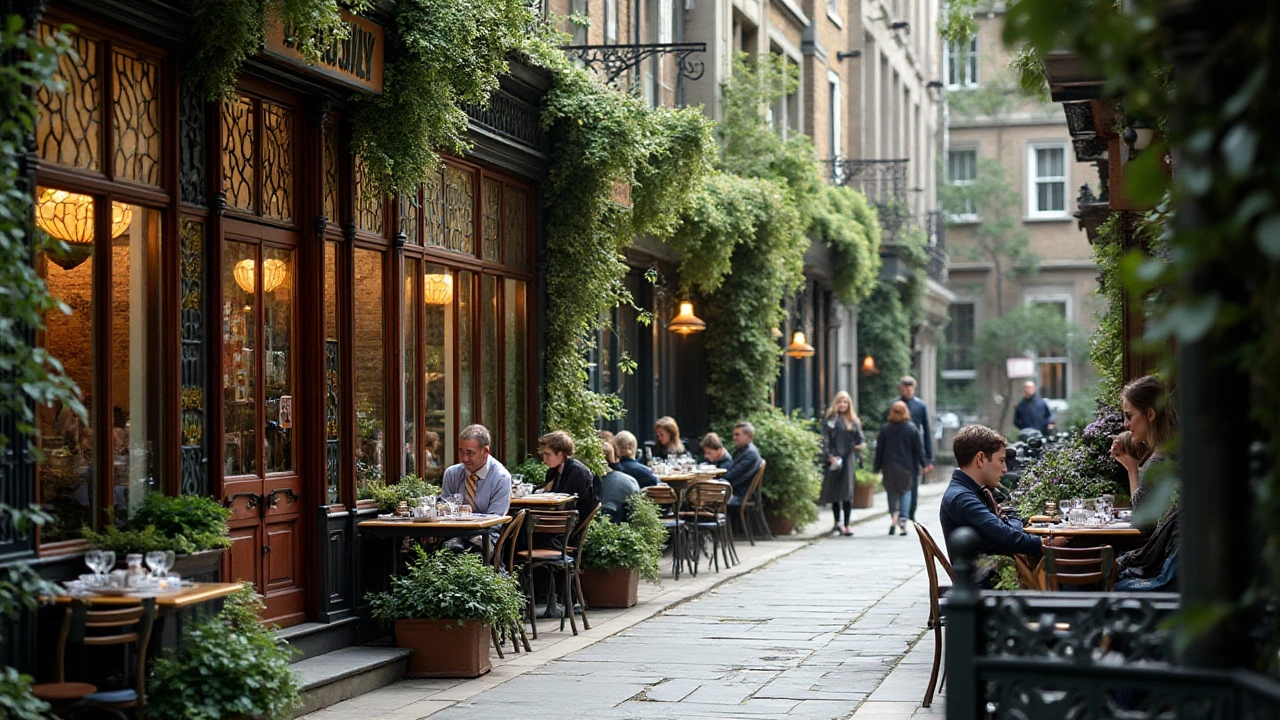
Modern Influence
Even a hundred years after its peak, Art Nouveau remains a significant influence in modern design and architecture. The movement's emphasis on organic shapes, intricate details, and nature-inspired forms continue to inspire contemporary artists and designers. You can see echoes of Art Nouveau in the sinuous lines of modern furniture, the nature-themed motifs in home décor, and even in today's graphic design.
One notable example of Art Nouveau's lasting impact on architecture is the work of Antoni Gaudí, whose influence extends well into the 21st century. Gaudí's imaginative buildings in Barcelona, such as the Sagrada Família and Casa Batlló, are cited as masterpieces that blend nature and architecture seamlessly. Modern architects have taken cues from his use of natural forms and organic structures, embodying them in sustainable and eco-friendly designs. A visit to these sites offers a window into how contemporary architecture can be both innovative and deeply rooted in Art Nouveau principles.
In the field of decorative arts, companies like Alessi and IKEA incorporate the flowing, natural lines and functional beauty characteristic of Art Nouveau in their products. These designs have a timeless appeal, making them both modern and classic at the same time. Present-day artisans and jewelers often look to the intricate patterns and organic shapes prevalent in Art Nouveau for inspiration, creating pieces that pay homage to the past while feeling fresh and modern.
Graphic design, too, owes a debt to the Art Nouveau movement. The emphasis on stylish typography, intricate borders, and natural elements has found a new home in everything from website design to packaging. Today's designers often draw from Art Nouveau's visual vocabulary, adapting its aesthetics to fit the digital age. This blending of old and new creates visually stunning works that feel both nostalgic and cutting-edge.
The world of fashion hasn't been immune to the charms of Art Nouveau. Designers like Alexander McQueen and Dries Van Noten have incorporated its flowing lines and intricate patterns into their runway collections. Fabrics and jewelry inspired by nature, with elaborate details reminiscent of Art Nouveau's heyday, make regular appearances in fashion shows and high-end boutiques. These designs capture the spirit of the movement, offering a romantic yet contemporary look that appeals to modern sensibilities.
Art Nouveau's legacy also lives on in contemporary public art and installations. Artists continue to create murals, sculptures, and decorative elements that evoke the style's organic beauty. Public spaces adorned with Art Nouveau-inspired works offer a sense of history and continuity, blending the past with the present in a way that's both engaging and meaningful. These modern interpretations breathe new life into the movement, ensuring that it remains relevant for future generations.
As we move further into the 21st century, it's clear that Art Nouveau's influence will continue to shape the world around us. From architecture and design to graphic art and fashion, the movement's core principles of natural beauty, intricate details, and organic forms have left an indelible mark. Whether in the sweeping curves of a modern building or the delicate patterns of a designer dress, Art Nouveau's legacy endures, reminding us of the timeless appeal of nature and creativity.
Interesting Facts and Tips
Art Nouveau, also known as Jugendstil in some regions, was a revolutionary style that left a lasting mark on art and architecture. But beyond its well-known characteristics, there are numerous fascinating aspects to this movement. For instance, Art Nouveau drew heavy inspiration from nature, which is why you'll frequently see motifs of flowers, plants, insects, and animals intricately woven into designs. This wasn't just for aesthetic purposes; it was a celebration of the natural world and a response to the rapid industrialization of society at the time.
One of the less-known but interesting facts about Art Nouveau is its influence on typography. Designers of the period created some of the most intricate and delicate fonts, often incorporating floral and natural elements into the letterforms. These fonts were not merely decorative but became integral to the overall design ethos of the period, blending text and visual art in novel ways. This practice has seen a resurgence in modern graphic design, showcasing the movement’s lasting impact.
Did you know that Art Nouveau had a significant presence in various world fairs? The 1900 Paris Exposition Universelle was a major showcase for this style. Several pavilions and exhibits featured Art Nouveau architecture and decorative arts, making it a pivotal moment for the international spread of the movement. This expo attracted millions of visitors, many of whom were experiencing this new style for the first time, which helped cement Art Nouveau's reputation worldwide.
Art critic Gabriel P. Weisberg once aptly noted, “Art Nouveau sought to elevate the ordinary to the extraordinary, merging fine and applied arts in ways that had never been imagined.”
When exploring Art Nouveau architecture, one cannot miss the work of Antoni Gaudí. His astonishing designs in Barcelona, like the Sagrada Familia and Park Güell, are prime examples of how the movement transcended traditional architectural forms. Gaudí’s work is characterized by fluid lines, organic shapes, and vibrant colors, embodying the essence of Art Nouveau. These sites remain some of the most visited tourist attractions in the world, demonstrating the enduring appeal of the style.
Let's not overlook Art Nouveau's impact on everyday objects. From elaborate glassware by Émile Gallé to exquisite jewelry by René Lalique, the movement redefined luxury in the decorative arts. These items weren't just functional; they were works of art designed to enrich daily life. Collectors still seek out these pieces, and their value continues to soar at auction houses, reflecting their timeless elegance.
For those looking to incorporate Art Nouveau elements into modern spaces, here are some practical tips. First, focus on natural motifs. Whether through wallpaper, fabric, or art prints, elements like flowing vines, floral patterns, and animal figures can add a touch of Art Nouveau to any room. Second, consider the use of stained glass. Incorporating stained glass elements, even in small features like lamps or window panels, can echo the movement’s celebration of light and color. Finally, don't shy away from curved furniture or furnishings with intricate details. These pieces can serve as stunning focal points while paying homage to the fluidity and elegance that define Art Nouveau.
In summary, Art Nouveau was not just a fleeting trend but a profound artistic movement that continues to inspire. Its emphasis on beauty, nature, and innovation has left an indelible mark on various facets of art, design, and architecture. As we've explored, the movement's influence is far-reaching and can be seen in modern design, collectible items, and architectural marvels. It's a testament to the timeless appeal of Art Nouveau that it still captures the imagination of artists and enthusiasts a century later.

